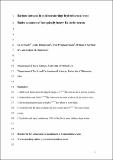Files in this item
Barium isotopes in mid-ocean ridge hydrothermal vent fluids : a source of isotopically heavy Ba to the ocean
Item metadata
| dc.contributor.author | Hsieh, Yu-Te | |
| dc.contributor.author | Bridgestock, Luke | |
| dc.contributor.author | Scheuermann, Peter P. | |
| dc.contributor.author | Seyfried Jr., William E. | |
| dc.contributor.author | Henderson, Gideon M. | |
| dc.date.accessioned | 2023-03-29T22:30:06Z | |
| dc.date.available | 2023-03-29T22:30:06Z | |
| dc.date.issued | 2021-01-01 | |
| dc.identifier | 283736639 | |
| dc.identifier | 240acab1-7ef4-4b03-9f5a-851ed26f56f3 | |
| dc.identifier | 85093940440 | |
| dc.identifier.citation | Hsieh , Y-T , Bridgestock , L , Scheuermann , P P , Seyfried Jr. , W E & Henderson , G M 2021 , ' Barium isotopes in mid-ocean ridge hydrothermal vent fluids : a source of isotopically heavy Ba to the ocean ' , Geochimica et Cosmochimica Acta , vol. 292 , pp. 348-363 . https://doi.org/10.1016/j.gca.2020.09.037 | en |
| dc.identifier.issn | 0016-7037 | |
| dc.identifier.other | ORCID: /0000-0001-7636-6090/work/131122780 | |
| dc.identifier.uri | https://hdl.handle.net/10023/27289 | |
| dc.description | Funding: These field and related experimental studies were supported through US NSF grants: 0549547, 0751771, 0813861, 0961188 and 1736679 (WES). | en |
| dc.description.abstract | Mid-ocean ridge (MOR) hydrothermal vent fluids are enriched with dissolved barium, but due to barite (BaSO4) precipitation during mixing between Ba-bearing vent fluids and SO4-bearing seawater, the magnitude of hydrothermal Ba input to the ocean remains uncertain. Deep-ocean Ba isotopes show evidence for non-conservative behavior, which might be explained by input of isotopically heavy hydrothermal Ba. In this study we present the first Ba isotope data in mid-ocean ridge hydrothermal vent fluids and particles from systems on the Mid-Atlantic Ridge (Rainbow 36°N and TAG 26°N), the East Pacific Rise (EPR9–10°N and 13°N) and the Juan de Fuca Ridge (MEF and ASHES). The vent fluids display a wide range of dissolved Ba concentrations from 0.43 to 97.9 μmol/kg and δ138/134Ba values from −0.26 to +0.91‰, but are modified relative to initial composition due to precipitation of barite. Calculated endmember vent fluid δ138/134Ba values, prior to barite precipitation, are between −0.17 and +0.09‰, consistent with the values observed in oceanic basalts and pelagic sediments. Water-rock interaction at depth in the oceanic crust appears to occur without Ba isotope fractionation. During subsequent venting and mixing with seawater, barite precipitation preferentially removes isotopically light Ba from vent fluids with a fractionation factor of Δ138/134Bahyd-barite-fluid = −0.35 ± 0.10‰ (2SE, n = 2). Based on knowledge of barite saturation and isotope fractionation during precipitation, the effective hydrothermal Ba component that mixes with seawater after barite precipitation has completed can be calculated: δ138/134Bahyd = +1.7 ± 0.7‰ (2SD). This value is isotopically heavier than deep ocean waters and may explain the observed non-conservative of Ba isotopes in deep waters. These new constraints on hydrothermal Ba compositions enable the hydrothermal input of Ba to Atlantic deep waters to be assessed at ≈3–9% of the observed Ba. Barium isotopes might be used as a tracer to reconstruct the history of hydrothermal Ba inputs and seawater SO4 concentrations in the past. | |
| dc.format.extent | 16 | |
| dc.format.extent | 3184986 | |
| dc.language.iso | eng | |
| dc.relation.ispartof | Geochimica et Cosmochimica Acta | en |
| dc.subject | Ba isotopes | en |
| dc.subject | Mid-ocean ridge | en |
| dc.subject | Hydrothermal | en |
| dc.subject | Barite | en |
| dc.subject | Isotopic fractionation | en |
| dc.subject | QE Geology | en |
| dc.subject | NDAS | en |
| dc.subject | MCC | en |
| dc.subject.lcc | QE | en |
| dc.title | Barium isotopes in mid-ocean ridge hydrothermal vent fluids : a source of isotopically heavy Ba to the ocean | en |
| dc.type | Journal article | en |
| dc.contributor.institution | University of St Andrews. School of Earth & Environmental Sciences | en |
| dc.identifier.doi | https://doi.org/10.1016/j.gca.2020.09.037 | |
| dc.description.status | Peer reviewed | en |
| dc.identifier.url | https://www.repository.cam.ac.uk/handle/1810/314975 | en |
This item appears in the following Collection(s)
Items in the St Andrews Research Repository are protected by copyright, with all rights reserved, unless otherwise indicated.

